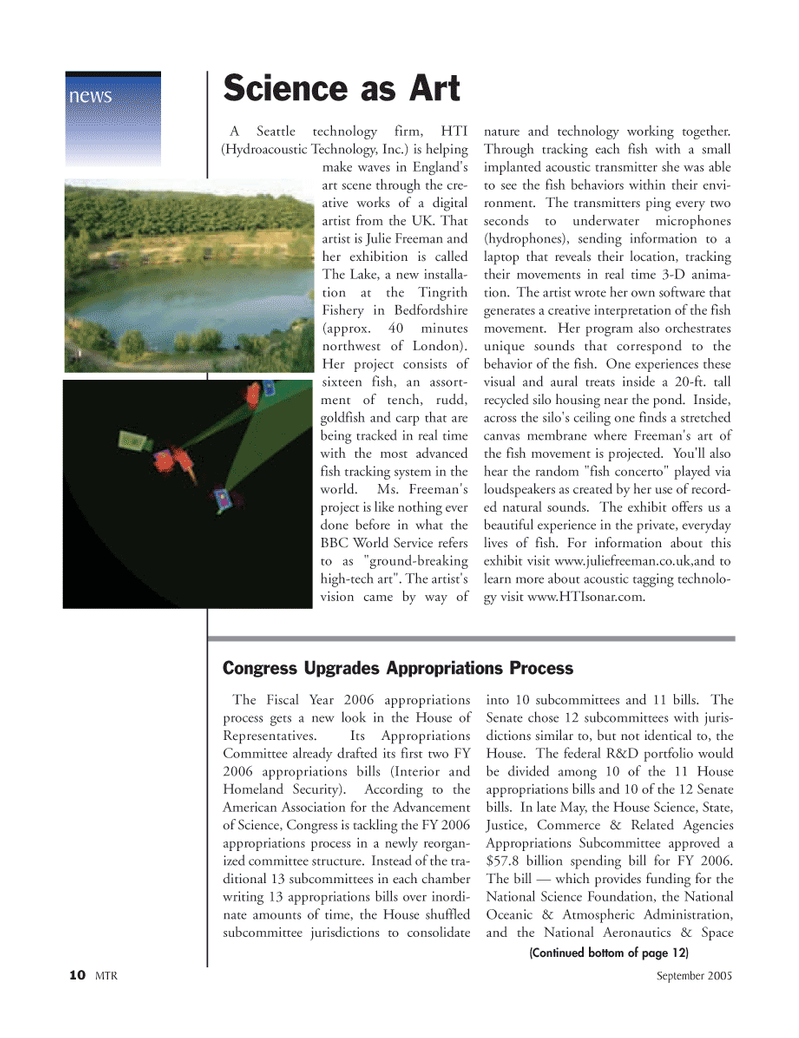
Page 10: of Marine Technology Magazine (September 2005)
Maritime Security & Undersea Defense
Read this page in Pdf, Flash or Html5 edition of September 2005 Marine Technology Magazine
10 MTR September 2005
Science as Art
A Seattle technology firm, HTI (Hydroacoustic Technology, Inc.) is helping make waves in England's art scene through the cre- ative works of a digital artist from the UK. That artist is Julie Freeman and her exhibition is called
The Lake, a new installa- tion at the Tingrith
Fishery in Bedfordshire (approx. 40 minutes northwest of London).
Her project consists of sixteen fish, an assort- ment of tench, rudd, goldfish and carp that are being tracked in real time with the most advanced fish tracking system in the world. Ms. Freeman's project is like nothing ever done before in what the
BBC World Service refers to as "ground-breaking high-tech art". The artist's vision came by way of nature and technology working together.
Through tracking each fish with a small implanted acoustic transmitter she was able to see the fish behaviors within their envi- ronment. The transmitters ping every two seconds to underwater microphones (hydrophones), sending information to a laptop that reveals their location, tracking their movements in real time 3-D anima- tion. The artist wrote her own software that generates a creative interpretation of the fish movement. Her program also orchestrates unique sounds that correspond to the behavior of the fish. One experiences these visual and aural treats inside a 20-ft. tall recycled silo housing near the pond. Inside, across the silo's ceiling one finds a stretched canvas membrane where Freeman's art of the fish movement is projected. You'll also hear the random "fish concerto" played via loudspeakers as created by her use of record- ed natural sounds. The exhibit offers us a beautiful experience in the private, everyday lives of fish. For information about this exhibit visit www.juliefreeman.co.uk,and to learn more about acoustic tagging technolo- gy visit www.HTIsonar.com. news
The Fiscal Year 2006 appropriations process gets a new look in the House of
Representatives. Its Appropriations
Committee already drafted its first two FY 2006 appropriations bills (Interior and
Homeland Security). According to the
American Association for the Advancement of Science, Congress is tackling the FY 2006 appropriations process in a newly reorgan- ized committee structure. Instead of the tra- ditional 13 subcommittees in each chamber writing 13 appropriations bills over inordi- nate amounts of time, the House shuffled subcommittee jurisdictions to consolidate into 10 subcommittees and 11 bills. The
Senate chose 12 subcommittees with juris- dictions similar to, but not identical to, the
House. The federal R&D portfolio would be divided among 10 of the 11 House appropriations bills and 10 of the 12 Senate bills. In late May, the House Science, State,
Justice, Commerce & Related Agencies
Appropriations Subcommittee approved a $57.8 billion spending bill for FY 2006.
The bill — which provides funding for the
National Science Foundation, the National
Oceanic & Atmospheric Administration, and the National Aeronautics & Space
Congress Upgrades Appropriations Process (Continued bottom of page 12)
MTR#2 (1-16).qxd 8/30/2005 4:46 PM Page 12

 9
9

 11
11
